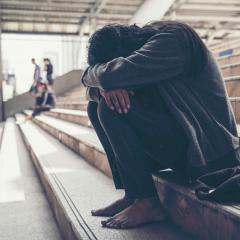Being poor isn't just about lacking material resources; it's also an emotional experience involving shame, anger and hope, explain Rose-Marie Stambe and Cameron Parsell from the UQ School of Social Science.
Shame is a common emotion associated with poverty, where people have feelings of unworthiness and erosion of self-esteem. These feelings can intensify when seeking charitable help, which many perceive as admitting failure to meet societal expectations. Yet, research has shown that many strive to negate, resist, or avoid these overwhelming feelings of shame and stigma – and also experience an array of other complex emotions.
In our recently published research, we studied people's experiences and feelings about receiving and giving charity. We used a relational ethnographic approach with 42 in-depth interviews and 95 days of participant observation to understand how helping plays out in practice and how people accessing help feel about their life circumstances, being helped, and what they need now and in the future.
Our research had three key findings. First, that faithful volunteers recognised that charitable giving could induce shame and so they deliberately tried to craft their helping practices through a religious-infused ‘hope’ framework. 'Hope' was integral to how charity service providers described their personal stories of helping. It formed part of the framework through which they understood their daily tasks, about who should be helped, how this helping should be done, and dovetailed into dominant social norms about which hopeful futures could be imagined. They wanted to give hope to people who are poor to change how they feel and how they act.
[Pastor Nancy] Then she said thermostats are there to change the temperature. She said they, as ‘people of hope’ should aim to be thermostats, to try and change the mindset for people, inviting them to be hopeful. She said this doesn't mean not acknowledging the present distress, but it is about looking to see ‘what could come next’ (Fieldnotes, 9 October 2021).
While hope was important for how the faithful tried to help, sometimes receivers of charitable help understood ‘hope’ differently. One service user who was also a faithful volunteer told us he like to try and inspire others with hope by providing his own experiences:
the hope for me is that they can see someone else has been there, done that, and is not doing too bad at the moment. It’s not going to be all roses’.
While the faithful volunteers used hope as a beacon of light, guiding individuals through hardships, allowing them to endure and find meaning in their adversities, his hope is entangled with his past struggles. As someone struggling with alcoholism, living below the poverty line, estranged from family and suicidal, the proximity of his daily struggles meant that hope and despair were intimately connected.
Third, our findings shows that shame and hope were not the only key emotions in the charity space. We also encountered anger. In the literature describes people navigating poverty often oscillate between feelings of "doing wrong" and "being wronged". Anger may arise from external confrontations, like the belittling experiences in welfare institutions. Yet in our research anger was both instrumental and transformational. Women, in particular, described their anger as useful – it helped them to persevere, but it also changed how they understood themselves as a subject:
And then people come up and they want to help me. And I just yell at them because I’m so defensive. I’m beyond, I’m toxic. I’m like, “Leave me the fuck alone.”
Anger isn't solely a product of shame. The spaces where anger surfaces might hold clues to other emotions and facets of the poverty experience that reside alongside shame. Thus, pigeonholing anger merely as a response to shame risks oversimplifying the complexity of human emotion. In our research, anger was a response to experiences of losing hope – but not because of the shame of being poor but the anger at being made poor:
You, the government, moved the goalposts there and left, especially single women, so many of us, in our cars. There’s thousands of women out there, but they’ve just been badgered, left behind, ignored, put down, intimidated, patronised.
Rather than hope symbolising a desire for a better future amidst uncertainty; it is a reminder of what is current, and what may continue. It's vital to approach this emotion critically. Who gets to feel hope, and what do we deem as hope-worthy? While hope may can be a powerful individual resource or utilised by the faithful to inspire, its uneven distribution in society or its misuse as a mere placatory tool can reinforce existing inequalities.
This article was originally published in The Power to Persuade, and has been republished with permission of the authors.



